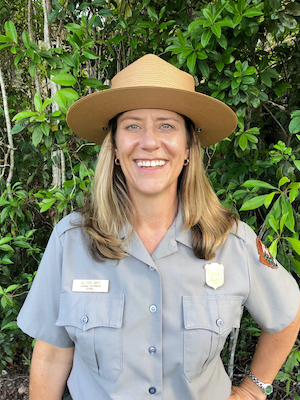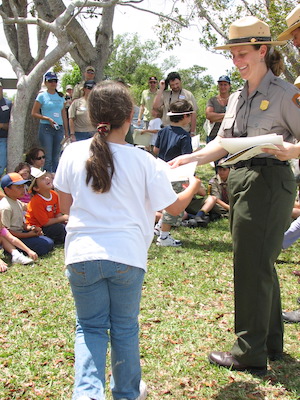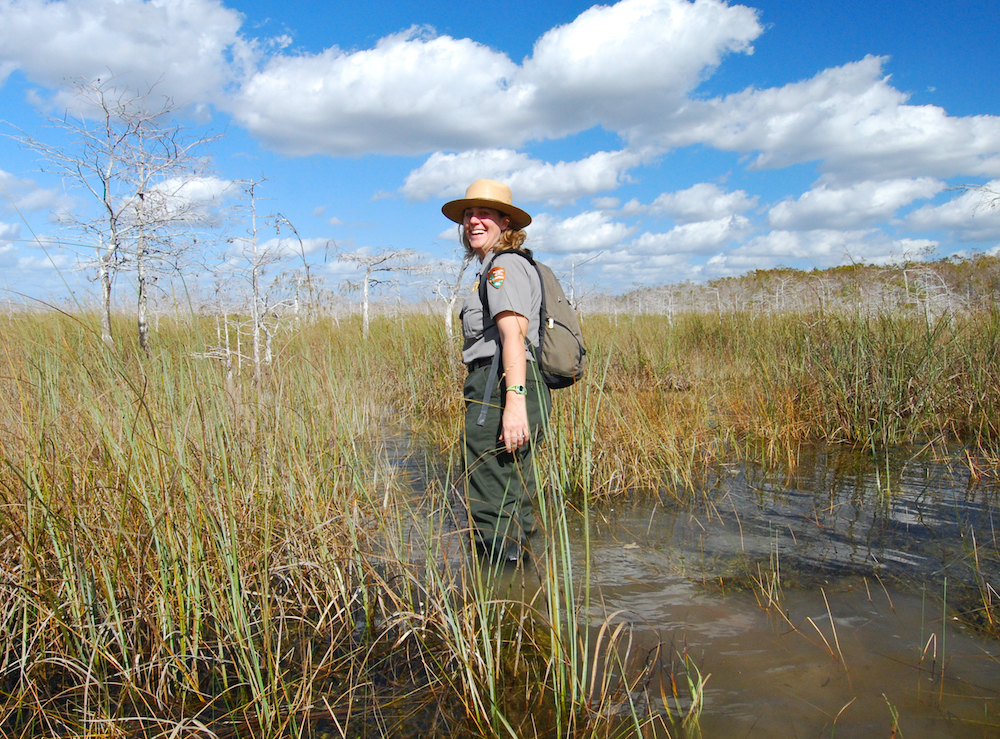Allyson Gantt inspires others to care for the Florida Keys’ two national parks and their unique environments. A National Park Service ranger for over 25 years, she directs communications and public affairs for both Everglades and Dry Tortugas national parks — designated by UNESCO as the Everglades & Dry Tortugas Biosphere Reserve.

Allyson, who has spent most of her National Park Service career in South Florida, is passionate about teaching park visitors about the natural world. (Photo courtesy of the NPS)
She’s also overseeing a year of activities for Everglades National Park’s upcoming 75th anniversary of its founding Dec. 6, 1947.
Allyson, who previously led Everglades education programs and park visitors on “slough slogs” or wet hikes, plans to launch monthly educational seminars in January to kick off the 75th celebration.
More than half of Everglades National Park lies within the Florida Keys, with about 455,000 acres of land in the Keys’ Monroe County and 387,000 acres encompassing Florida Bay. A renovated Flamingo Visitor Center and all-new 24-unit Flamingo Lodge & Restaurant are to be unveiled at the park in 2022.
At Dry Tortugas National Park, a cluster of seven tiny islands 70 miles west of Key West, a $4.5 million, three-phase full restoration of the 144-year-old iron-plated Tortugas Harbor Lighthouse is underway.
For Allyson, Dry Tortugas holds precious memories. The remote jewel of a park is where she lived for two months as site manager, created and led a curriculum-based education program for middle school students, and got engaged to her husband.
A native of Pitman, New Jersey, she landed a National Park Service paid internship through the Student Conservation Association at Rutgers, the State University of New Jersey. She has also worked at Arizona’s Glen Canyon National Recreational Area and Wyoming’s Grand Teton and Maine’s Acadia national parks.
Keys Voices: When did you first come to the Florida Keys and why?
Allyson Gantt: In winter 1996 during my first season at Everglades. I snorkeled at John Pennekamp Coral Reef and camped at Long Key state parks.

Allyson derives great satisfaction from inspiring the next generation to care about America’s national parks and environment. (Photo courtesy of the NPS)
KV: What aspects of the Keys environment or way of life matter most to you?
AG: The crystal-clear water in all those shades of blue captivated me. I fell in love with mangroves and their fascinating ability to survive saltwater. I’m passionate about educating others about protecting our coral reef, especially from stony coral tissue loss disease.
KV: Who or what inspired you to become passionate about respecting and protecting the Keys’ natural world?
AG: My dad was instrumental in my love of nature and opened my eyes to my chosen career path. When I was growing up in New Jersey, he took us all up and down the East Coast and across the country to enjoy our national and state parks.
KV: How does that passion influence your work or profession?
AG: Exposure to national parks as a kid came back when seeking a summer job in college. I traveled the country for a few years before landing in Florida.
KV: What are some of the ways, personally or through your work, that you connect with and/or help protect the local environment and unique lifestyle?
AG: I feel a strong sense of mission for what we do in our national parks. The complexities and the beauty of the Everglades aren’t always obvious. What’s fascinating is the interconnectedness in the details. Sometimes it takes leading someone by the hand, but later they begin to appreciate what’s right in front of them.
KV: What keeps you energized, challenged and focused on your path?

Allyson displays the beauty of Loggerhead Key at Dry Tortugas National Park. The remote park is where she got engaged to her now-husband. (Photo courtesy of the NPS)
AG: Constantly learning and teaching about the natural world, our shared history and resources in our parks. Knowing I can make a difference for park visitors — whether teaching something new, something they’ve never tried like canoeing or a wet hike, or how to recreate safely in the parks — is what keeps me going.
KV: What do you hope your positive environmental actions will accomplish?
AG: The Everglades Education Program was my most meaningful job, inspiring the next generation to care about our national parks and our environment. Today I still get to “teach,” but to a broader audience through social media, park websites and media contacts.
KV: What message do you want your actions and example to communicate to people you encounter?
AG: We can all do our part to conserve water and electricity and reduce waste no matter where we live. In the Keys we can help protect our crystal-clear waters, mangroves, corals and sea life by being good stewards of our environment.
KV: What’s your favorite natural or eco-friendly activity in the Keys?
AG: Paddling in Florida Bay at sunset, watching birds fly home to roost for the night, catching a glimpse of a dolphin or sea turtle, and enjoying the peace of the flat, calm water when the sea melts into the sky.

